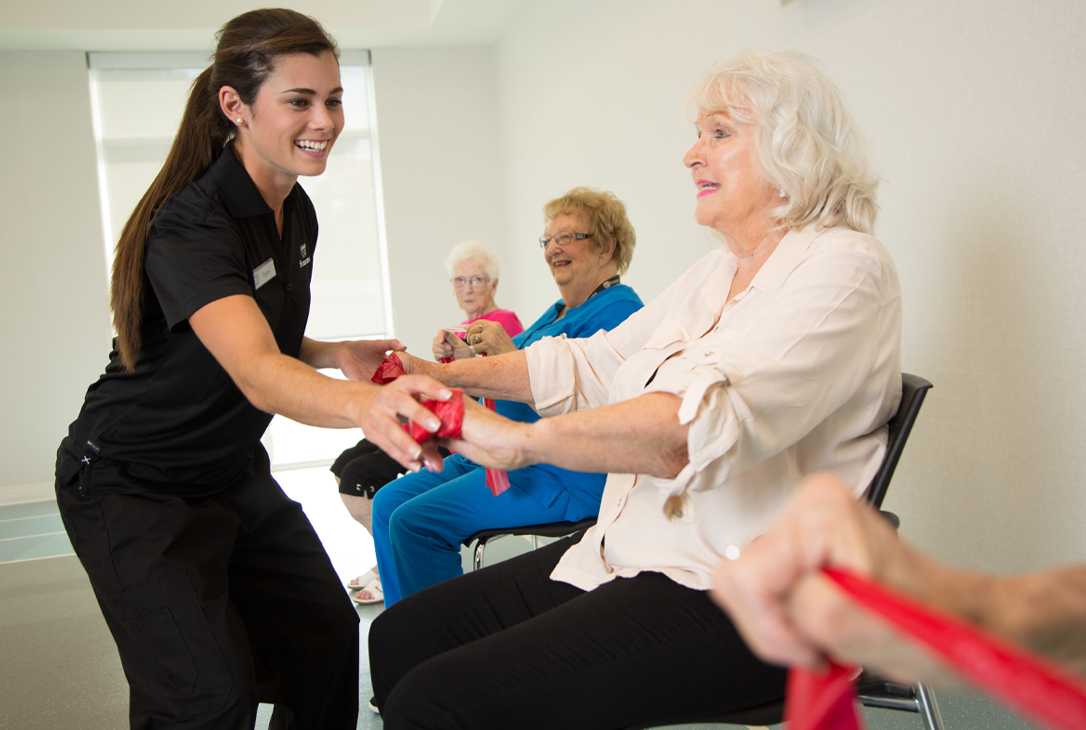
Exercise and physical activity have long been associated with numerous physical health benefits. Many of us know that having a fitness regimen helps maintain a healthy weight, strengthens muscles and bones, improves cardiovascular health, and reduces the risk of chronic conditions such as heart disease, diabetes, certain types of cancer, and more. Exercise also enhances flexibility, balance, and coordination, which become increasingly important as we age. However, its impact extends far beyond just the physical benefits. Engaging in regular exercise can have a profound and often unexpected effect on our overall well-being, including social, emotional, and cognitive health.
Let’s talk about some of these lesser-known benefits of exercise.
Social Engagement:
Being physically active can be a fantastic way to forge social connections and combat feelings of loneliness. When surveyed, older adults often report that they enjoy the social aspect of their fitness classes the most. Participating in group exercises, fitness classes, or sports activities fosters a sense of community and belonging.
Emotional Well-being:
Physical activity has a profound impact on our mental and emotional well-being. When we exercise, our bodies release endorphins, natural mood enhancers that promote happiness and reduce stress and anxiety. Engaging in physical activity can alleviate symptoms of depression and boost self-esteem and confidence. It also fosters a sense of accomplishment and empowers individuals to take control of their health.
Cognitive Function:
Numerous studies have demonstrated that regular physical activity is associated with various cognitive benefits, including improved memory, enhanced executive function, and a reduced risk of cognitive decline and dementia. One of the simplest mechanisms responsible for this benefit is improved blood flow to the brain, delivering more oxygen and nutrients to brain cells. Physical activity also supports neuroplasticity, the brain’s ability to reorganize and form new neural connections. This plasticity is crucial for learning and memory processes, which aid in short-term (working) and long-term memory formation.
Other physical benefits:
Regular physical activity can significantly improve the quality of sleep. Exercise helps regulate our sleep-wake cycle, promoting a more restful and rejuvenating sleep. By increasing time spent in deep sleep, physical activity enhances memory consolidation, cognitive function, and overall alertness during the day. Older adults who exercise regularly often report fewer sleep disturbances and a higher quality of sleep.
Our appetite and eating habits may change as we age due to various factors, including decreased metabolic rate and hormone changes. Regular exercise can help mitigate some of these changes and improve appetite. Exercise helps boost metabolism, mainly through strength training and aerobic activities. A higher metabolic rate means the body burns more calories even at rest, increasing appetite and making you hungrier. Regular physical activity can aid in better digestion and nutrient absorption. As a result, you may feel more comfortable and less bloated after meals, which can make you want to eat more.
What to Include in Your Daily Routine:
Now that you know the benefits, you might wonder what you should do to reap them. Older Adults should aim for a balanced exercise routine that includes cardiovascular activities, strength training, flexibility, and balance exercises. Examples include brisk walking, swimming, cycling, yoga, tai chi, and resistance training. It’s important to start slowly and gradually increase the intensity and duration of workouts while always listening to one’s body and consulting with a healthcare professional if necessary. Aim for 150 minutes of cardiovascular activity, like walking, per week. Engage in exercises to strengthen your muscles and bones twice per week. Aim to move your body every day, throughout the day.
How Senior Living Fits in:
Living in a retirement community provides ample opportunities to embrace an active lifestyle. Retirement communities offer an excellent opportunity to access high-quality fitness classes and exercise amenities without needing a gym or community centre membership, a commute, or weather-related impact. They not only provide opportunities for groups, clubs, and events that revolve around physical wellness but also allow older adults to continue building meaningful relationships after the session. Living in a retirement community makes exercising regularly easier and accessing a supportive environment that encourages healthy habits and provides a sense of community and companionship. Engaging in regular physical activity is a powerful tool for promoting holistic well-being. Its benefits extend beyond physical health, enhancing social, emotional, and cognitive health. Adopting an active lifestyle can improve your overall quality of life, enhance your well-being, and allow you to enjoy the numerous advantages of residing in a retirement community. Embrace the joy of movement and unlock the full potential of your well-being through physical activity!
About the Author
Emily Johnson is the Founder of StrongerU Senior Fitness – a fitness education company that trains activity and life enrichment staff working in retirement and long-term care homes to deliver quality fitness programs with an online instructor course and 30 minutes of monthly class content to learn and teach to the residents. She is on a mission to innovate and elevate senior fitness globally by empowering recreation, fitness, and wellness professionals to deliver high-quality senior fitness classes and debunking common misconceptions about aging and exercise. Emily has trained more than 900 senior fitness instructors across Canada, the U.S., Australia, and New Zealand, primarily in senior living settings. Learn more at https://www.strongeruseniorfitness.com/